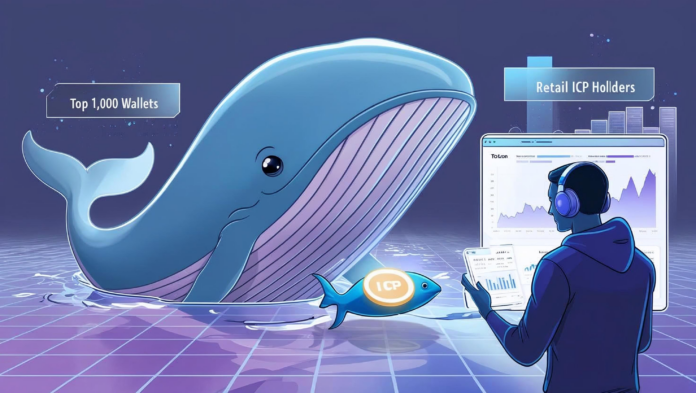Fabio, a YouTuber known for his detailed content on market manipulation, regulatory risks, and risk management, has stepped into the noise surrounding Internet Computer Protocol (ICP) with some pointed observations. With speculation swirling online about whether DFINITY—the not-for-profit foundation behind the protocol—is offloading tokens on the public, Fabio took to X to break down what he sees as a misreading of the data.
Instead of wading into the online drama with conjecture, Fabio’s method is data-driven. He monitors wallet activity across the ICP ecosystem, focusing on the top 1,000 wallets by size. It’s a technical approach, but one that offers valuable insights into token distribution trends. According to his latest findings, 9 out of the top 15 ICP wallets haven’t moved since 2022. This sort of inactivity can suggest long-term holding rather than dumping. Large holders sitting still doesn’t necessarily spell trouble for a project—if anything, it can indicate conviction.

Zooming out to assess broader shifts, Fabio noted only slight changes among the top 1,000 wallets. His year-on-year comparison revealed a mere 2% drop in holdings by this group. That change may raise eyebrows, but when viewed alongside growth in smaller wallets, the picture shifts. Over the past year, there’s been a 26% increase in what Fabio refers to as “meaningful wallets”—those holding more than 10 ICP. That’s a decent signal of increasing retail investor participation, with more individuals choosing to buy in and hold, rather than one dominant group concentrating supply.
For Fabio, this trend suggests a slow, organic redistribution of tokens from early large holders—often referred to as whales—to smaller investors. He argues this is not just expected, but necessary, for broader network adoption. A project like ICP aims for decentralisation and accessibility. If the tokens were permanently locked up in a handful of wallets, adoption would stagnate. As Fabio points out, a token can’t meaningfully grow its user base if most of the supply never changes hands.
Addressing the criticism that DFINITY is liquidating ICP for cash, Fabio reminded followers that DFINITY has openly used some of its token reserves to pay developers since the project launched. That’s not a new revelation. Building infrastructure at the scale DFINITY envisions—one that could potentially reshape how the internet operates—is not something done for free. Salaries, research, operations, and tech development all come at a cost. Paying developers in ICP or liquidated ICP is standard for a crypto foundation with large native holdings. It’s not scandalous; it’s budgeting.
Another point Fabio raised is that DFINITY has continued to re-stake portions of its ICP, a move that appears at odds with accusations of dumping. Staking implies a commitment to the network’s long-term health. Locking up tokens rather than selling them doesn’t align with a liquidation narrative. If DFINITY were planning to cash out heavily, there would be little logic in voluntarily restricting its liquidity by staking.
Fabio also reminded followers of the initial token distribution from Genesis. The allocation details were public and accessible to anyone willing to read the documentation. Early-stage crypto projects often come with transparent vesting schedules and known allocations. Many of the criticisms cropping up now, he says, stem from investors not revisiting the basics. If those details weren’t considered before entering the market, the oversight lies with the individual, not the foundation.
The conversation then turned to exchange-based ICP supply, which has risen from 7.7% to 9.45% over the past year. While any increase in tokens held on exchanges may look worrying at first glance—it can imply a readiness to sell—Fabio puts the figure in context. Around 10 million tokens were unlocked from the Network Nervous System (NNS) in the same period, and token inflation continues. Under those conditions, a slight increase in exchange supply seems natural, rather than alarming.
None of Fabio’s commentary leans on empty optimism or vague platitudes. Instead, he positions his observations as factual counters to online panic. In a digital world where misinformation can spread rapidly, particularly in crypto circles, his measured, data-backed responses aim to reset the tone of the conversation.
He also extended an offer: if people wanted a more detailed breakdown, he’d be happy to put together a full video. His online following appreciates the transparency and the effort to cut through what he sees as misinformation. That sort of availability is rare among technical analysts, especially those with niche expertise in regulatory and manipulation frameworks.
The timing of Fabio’s thread matters. ICP has seen a mix of hype, criticism, and confusion since its launch. Once hailed as a project that could rival the current internet structure, it’s also faced scrutiny over its early tokenomics and decision-making. With so many eyes on the project and its foundation, DFINITY’s every move is often put under a microscope.
That makes voices like Fabio’s valuable. He doesn’t represent DFINITY, nor is he blindly defending the foundation. What he’s doing is asking the online community to step back and assess what the data actually shows. His stance is that instead of jumping to conclusions based on a few screenshots or charts without context, people should understand what token movement really looks like in a maturing protocol.
As a specialist in preventing market manipulation, Fabio’s lens is one of structure and oversight. His approach isn’t about spinning a narrative—it’s about identifying whether there’s anything in the numbers that actually supports the claims being made. In this case, he sees no pattern consistent with large-scale dumping by DFINITY. What he sees is a relatively stable distribution landscape, growth in new holders, and activity that lines up with typical development behaviour.
The ICP community, like many crypto communities, often finds itself at the intersection of speculation and long-term belief. Volatility is part of the game, but so is patience. As protocols evolve, so does the conversation around them. For now, Fabio’s data snapshot gives the community something firm to chew on—less opinion, more observation.
Whether this helps shift public sentiment remains to be seen, but it does highlight a growing appetite for evidence-based commentary. As more voices enter the space and projects like ICP continue to mature, the balance between emotion and data may well determine which narratives stick. For now, Fabio’s hoping the facts speak for themselves.


